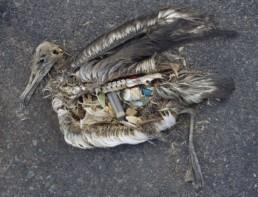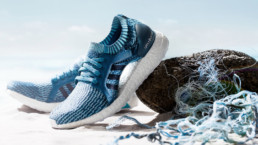Plastic is one of the most celebrated and widely used materials in modern society. But even though it is extremely useful and resilient, it is harming our environment on multiple levels. Not only are most plastics made from fossil fuels, which contribute to our warming climate, we humans also have a hard time keeping them on land. Our oceans are filled with plastic waste and an estimated 8 million tons of it is added every year. According to the Ellen MacArthur Foundation, we might have more plastic than fish in our seas by 2050 if we keep using the big blue as a giant dumpster, which truly is a terrifying forecast.
Right now about five plastic gyres travel our global seas. They are garbage patches of billions of pieces of plastic forming mile-long underwater soups (and not islands, which is a general misconception). Broken down by the tides, UV radiation and chemical decomposition, these small pieces along with bigger chunks end up harassing marine life in all sorts of ways. Just take a look at the horrific video of marine researchers removing an intact plastic straw from a seas turtle’s nostril, the haunting photos by Chris Jordan of dead albatrosses with stomachs full of bottle caps and disposable lighters, or the recent study that has found fish eat plastics like teens eat fast food. Evidence of how plastic is poison for life in and around our oceans is abundant—a quick search on the Internet may easily leave you feeling appalled and distressed.

On the positive note, there is also a growing number of entrepreneurs and start-ups working to reduce and recycle plastics in the deep blue. Some of them even make sure the straws, cups and bags drifting in our waters find their ways into the things we wear.
From ocean trash to new fash
The fashion industry is incredibly resource-intensive. Take cotton as an example: it is such a thirsty crop that making a T-shirt requires approximately 2,700 liters and almost triple that amount for a pair of jeans. So why not start digging into some of the plastic trash in our seas to make new materials? Some start-ups and projects already have.
Bionic Yarn, which has musician and producer Pharrell Williams as its creative director, is making durable fabric threads from up to 100% recovered plastic bottles, recently from other ocean plastic waste as well. In three years, the company has turned more than 7 million plastic bottles into new threads which have been sold to its partners G-Star and O’Neill among others. Plastic bottles are particularly well-suited to produce new textiles as they contain the same polymers as polyester. H&M has recently become a fan of the idea too, and has introduced Bionic Yarn in its 2017 Conscious Exclusive collection.
Sports fashion giant Adidas has also dug into the plastic masses in our seas. The company collaborated with Parley for the Oceans to make running shoes made partly from plastic waste found on beaches. Fashion designer Stella McCartney is also onboard with the idea and has designed adidas’ new Parley UltraBOOST X running shoes.

Finally, Aquafil’s Econyl Regeneration System is worth mentioning. Nylon can easily be broken down to its original state. Aquafil takes advantage of this as it collects old fishnets and other nylon waste and turns it into a yarn that can be used for textiles, fabric and carpets. With 30,000 tons of waste recycled through the system in just two years, the company limits new production of oil-based nylon and keeps plastics from entering the sea.
A plastic-wrapped warning
For these kinds of solutions, the output is relatively small and the impact limited. However, fashion can help deliver the message that we are too reckless with plastic waste and too ignorant about its impact on our oceans. As Parley for the Ocean’s founder Cyrill Gutsch explained to Sneakers Magazine, “a product can be the most efficient messenger for a cause. A product made from the very problem we are fighting to fix only amplifies the message.” Additionally, with 165 million tons of plastic in our oceans, there is enough for millions of shoes, shirts and skirts, and a growing number of conscious consumers worldwide interested in supporting the cause.
Of course, collecting ocean plastics doesn’t quite address the root of the problem. Propylene-derived plastics, which most plastics are, never biodegrade completely, and we therefore need solutions to replace these plastics with more sustainable materials. We also need more solutions to stop plastic from reaching our seas in the first place, as well as solutions to retrieve ocean plastic more efficiently, like the ones presented by the Seabin Project and the Ocean Cleanup. However, making clothes and textiles from the plastic trash that is already in our oceans can send a strong message and get us dressed up for a serious fight for plastic-free seas.
Find more solutions that help solve SDG #14 (Life Below Water) and learn more about the market for recycling ocean plastics on the Explorer.
Author: Joachim Marc Christensen

